Frequently Asked Questions About the Costs of California's Death Penalty
Page Media
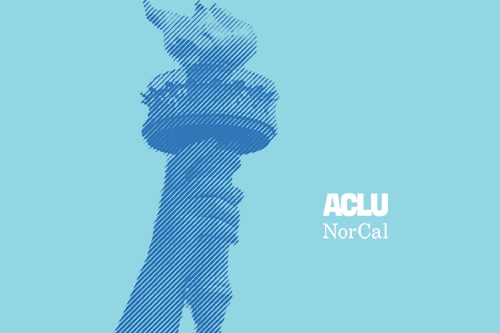
Many people are surprised to learn that it costs more to sentence someone to execution than permanent imprisonment, also known as life without parole. This page highlights key findings from the ACLU-NC's report The Hidden Death Tax: The Secret Cost of Seeking Executions in California to answer some frequently asked questions about the costs of California's death penalty system.
Click to view our Powerpoint: "The Costs of the Death Penalty and Who Pays the Price" (March 2010)
For facts and figures at a glance, see also:
- Budget Concerns Force States to Reconsider the Death Penalty, CNN.com, March 2, 2009
- What We Sacrifice on Death Row, San Francisco Chronicle, June 2008
1) Does it cost more to sentence someone to execution than to sentence them to permanent imprisonment?
Yes. At every step of the process, the death penalty costs more.
- Death penalty trials cost an estimated $1.1 million more than a trial where the District Attorney seeks a sentence of permanent imprisonment. Unlike post-conviction costs funded by the state budget, trial expenses are borne largely from county budgets.
- Housing on death row costs at least$90,000 more per inmate per year than housing in the general prison population, where those sentenced to permanent imprisonment are housed.
- Funding for post-conviction prosecution and defense attorneys costs $85,000 per death row inmate per year. Inmates sentenced to permanent imprisonment are not afforded mandatory appeals.
As of 2009, California taxpayers spend an estimated $117 million each year at the post-conviction level seeking the execution of the 680 inmates on death row.
Death penalty trials cost local taxpayers an additional $20 million per year, at the current death sentencing rate of 20 sentences per year.
In total, the death penalty system cost California taxpayers $137 million each year, the California Commission on the Fair Administration of Justice found, whereas permanent imprisonment for all those currently on death row would cost just $11 million.
On top of all of that, we need to spend $400 million to construct a new facility to house death row inmates, because the current facility is too old and overcrowded. If every person on death row were condemned to permanent imprisonment instead, we would avoid this expense.
Read more about the costs of the death penalty.
See the chart published by the San Francisco Chronicle in June 2008, depicting what we spend on the death penalty in California. Since publication, the death row population has risen to 680.
2) Why do death penalty cases cost more?
Death penalty cases cost more than other murder cases because state execution is fundamentally different from sentencing someone to die in prison of other causes. Mistakes cannot be undone when innocent people are executed. Nationwide, more than 130 innocent people have been freed from death row since 1971.
Unlike other murder cases, death penalty cases typically have two trials: one to determine whether the defendant committed the crime, and one to decide whether he should be executed. In addition, everyone involved in a death penalty case must be specially “qualified” as capable and experienced, including the defense attorneys, the judge and the jury.
While some effort has been made to account for the financial costs of the death penalty, little attention has been paid to the demands on prosecutors and law enforcement. The ACLU-NC reviewed records of several murder trials and found, for example that the Scott Peterson trial consumed more than 20,000 hours of prosecutor staff time. This is equivalent to nine full-time staff people for a year. In fact, 33 employees worked on the prosecution's case, including five attorneys and seven investigators.
Defense costs in death penalty trials are also significantly higher than in other cases because of the greater obligations of representing clients facing execution. The ABA Guidelines for Death Penalty Representation require a four-member defense team in every potential death penalty case: two attorneys and two investigators. This is twice the usual defense staffing in a murder case.
The courts, too, spend more on death penalty cases, which typically take years to bring to trial and many months of court time once the trial begins. When substantial court resources are taken up by death penalty trials, the court cannot handle other cases and as a result, additional judges and courtroom staff may be needed.
After sentencing, all death penalty cases go through a series of appeals to review the judgment of the trial court and ensure that the person was not sentenced to execution for the wrong reason, such as race, poverty or even despite being innocent. The appellate system is currently under-funded, with dozens of inmates without lawyers. Nevertheless, in its current dysfunctional state, funding for qualified attorneys and courts to handle appeals totals millions of dollars each year.
Read more about why the death penalty costs more.
3) How much more does a death penalty case cost?
There is currently no comprehensive system for tracking the costs of death penalty trials. Attorneys and the courts are generally not required to disclose costs, except a small number of cases where thethe state reimbursed the costs of the trials.
In The Hidden Death Tax, the ACLU-NC requested and reviewed state records of trials funded through this program, and arrived at some key findings:
- The difference between the least expensive death penalty trial and most expensive non-death penalty murder trial was $1.1 million. The death penalty trial of People v. Suarez cost $1.8 million, and the non-death penalty trial of People v. Franklin cost $661,000.
- One death penalty trial -- People v. Charles Chitat Ng -- cost $10.9 million, Several other death penalty trials also cost multiple millions of dollars.
- Most trial costs still remain hidden, but the record keeping required by this program reveals that it would be feasible to require more comprehensive accounting in all cases.
The following graphs demonstrate the breakdown of costs for 4 homicide trials where the best records were kept.
People v. Scott Peterson, Death Penalty Trial
$3.2 Million Total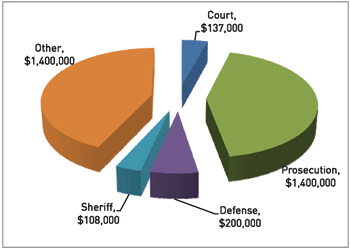
People v. Rex Allen Krebs Death Penalty Trial
$2.8 Million Total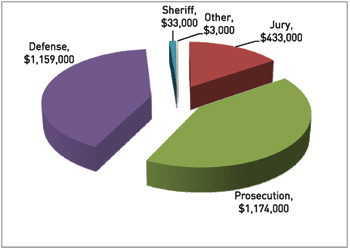
People v. Cary Stayner, Death Penalty Trial
$2.368 Million Total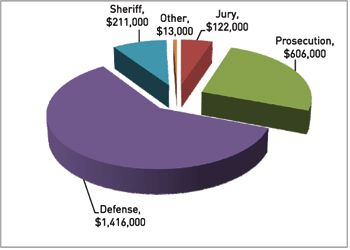
People v. Robert Wigley, Non-Death Penalty Trial
$454,000 Total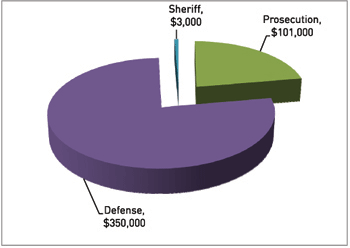
The chart below compares the overall costs of some death penalty and non-death penalty trials.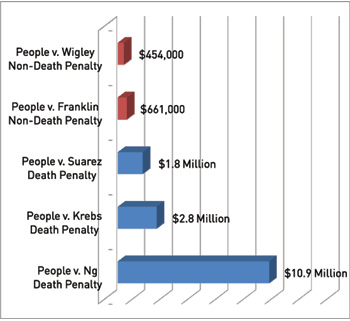
Read more about the costs of death penalty trials and key case studies.
4) How much money could we save if everyone sentenced to execution were sentenced to permanent imprisonment instead?
If everyone currently sentenced to execution were sentenced to permanent imprisonment instead, California taxpayers would save $1 billion in five years. The costs breakdown as follows:
- $125 million saved each year. The California Commission on the Fair Administration of Justice found that the death penalty system currently costs California taxpayers $137 million each year, whereas the alternative of permanent imprisonment would cost just $11 million. If all death sentences were converted to permanent imprisonment, the state would save over $600 million in 5 years. Read the full report.
- $400 million in the construction of a new death row facility. This is what the State Auditor says it will cost to rebuild death row at San Quentin.
5) Why do people stay on death row for so long? If we "speed up" the death penalty, won't that make the death penalty cheaper?
No. Any effort to "speed up" executions will only cost more money. It is true that a person sentenced to execution is much more likely to die of illness or old age than they are to be executed. 64 people have died on death row awaiting executions since 1978, while only 13 have actually been executed; the average wait on death row is over 20 years.
The California Commission on the Fair Administration of Justice found that the only way to make the death penalty system operate more efficiently is to provide more funding for competent defense and prosecution counsel and for the courts. The Commission’s proposal to do so would cost the state an additional $95 million per year, above and beyond the $137 million we currently spend on the system. Therefore, any reforms to ensure death penalty cases move quicker through the system would require more money, and would not save the state a dime.
For more information about the costs of the death penalty, see The Hidden Death Tax: The Secret Costs of Seeking Execution in California.
